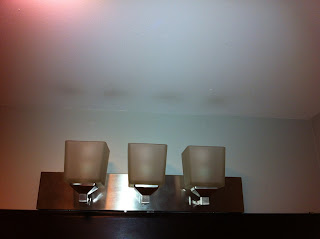Anyways, we had to replace the bottom (first) stair of our staircase because of a certain striped animal in our house.
Here's a list of supplies:
- carpet pad (we are very fortunate and got it from a friend- thanks Kyle!)
- carpet (*found a very small remnant at Home Depot)
- staple gun (we rented an electric one from Home Depot)
- work gloves (there are a lot of nails and staples that'll stab you)
- tack strip
- nails
- carpet trimming knife (we used an x acto knife)
- carpet tucker (we actually used a putty knife)
- stair tread
- hammer
- cat's paw (this is a real tool which I thought was really cute and we borrowed it from a friend- thanks Chris!)
- knee kick (we rented from Home Depot but we ended up not really needing it)
Step one: Put on gloves and remove the carpet from the riser.
 |
| BEFORE |
Step two: Take your hammer or cat's paw (if the nails were driven extra deep) and remove the nails from the riser. We had to use the cat's paw. Pull really hard to remove the riser completely.
 |
| Ew |
Step three: Place your new riser onto existing frame using your hammer and nails.
 |
| I forgot to take a picture of the new riser but here's one with foil on it to protect it from previously mentioned striped animal. |
Step four: Place tack strip approximately 1in away from the next stair. Use your hammer and hammer in the larger nails. Make sure to not hammer the small tacks.
Step five: Using your utility knife cut carpet pad to size (to fit the tread) and using staple gun staple into place. Do not place pad on tack strip.
Step six: Using your utility knife cut carpet to fit sides, bottom and top of riser. We did a cap-and-band style on this stair due to the carpet not being long enough to do the waterfall style (like the rest of the stairs are in) but we figured since it was the bottom stair it didn't really matter. Using your staple gun staple the heck out of the carpet. Using your carpet tucker (or in our case putty knife) tuck carpet into the the crease behind the tack strip and smooth out carpet.
And here is the finished product....
We think it looks pretty good for a first time. Craig and I really enjoy working together on projects and it makes it a lot more fun! Quite a few Youtube videos were watched and it was difficult to find any where just the bottom stair was being replaced. Total cost= $60.00
*Carpet remnants are typically sold in LARGE sizes (11x15ft). We only needed approximately 3 1/2x6ft. It was difficult to find and we were afraid we were going to have to replace all the carpeting but we thankfully found a similar color in a small size.
.JPG)










































